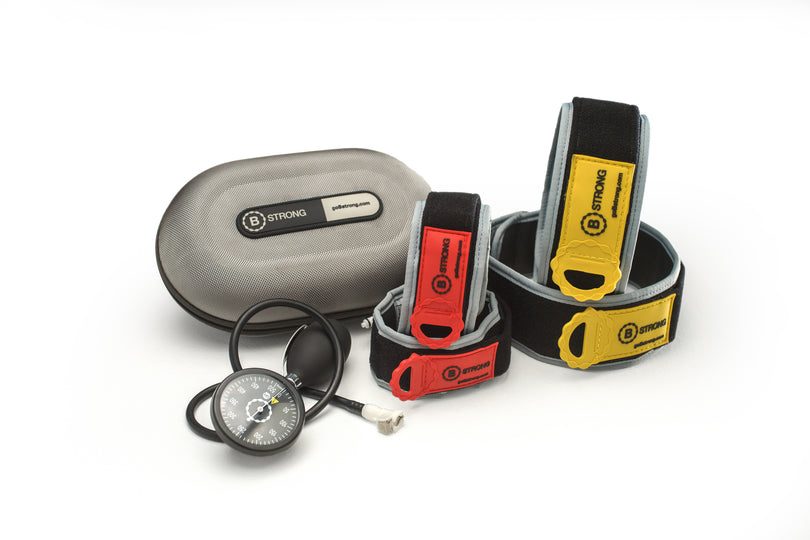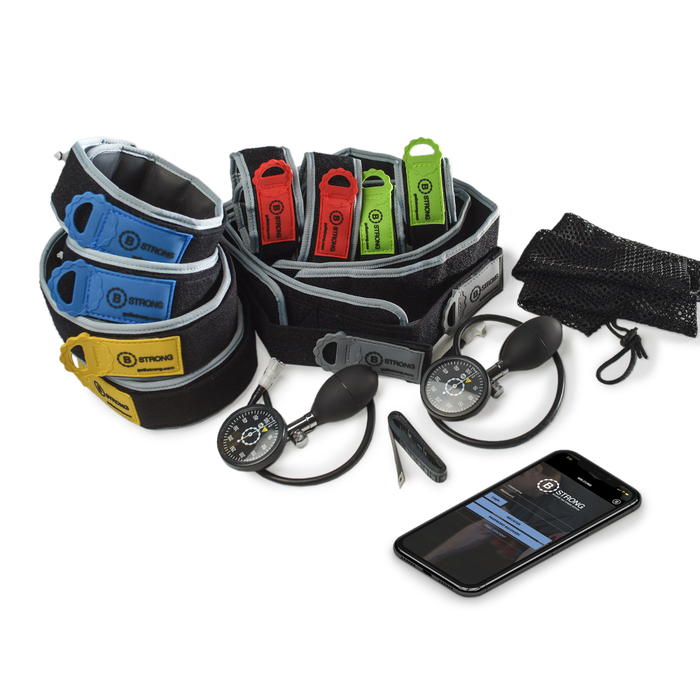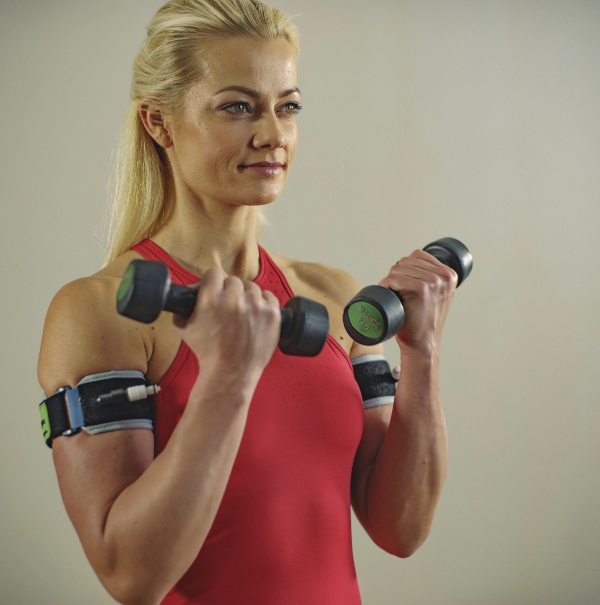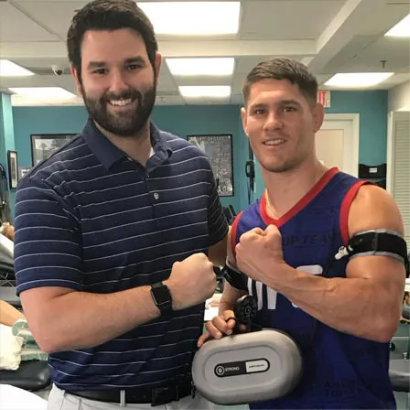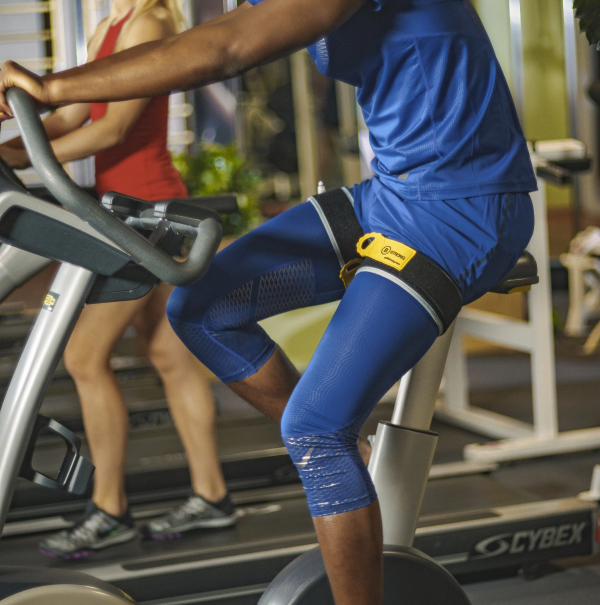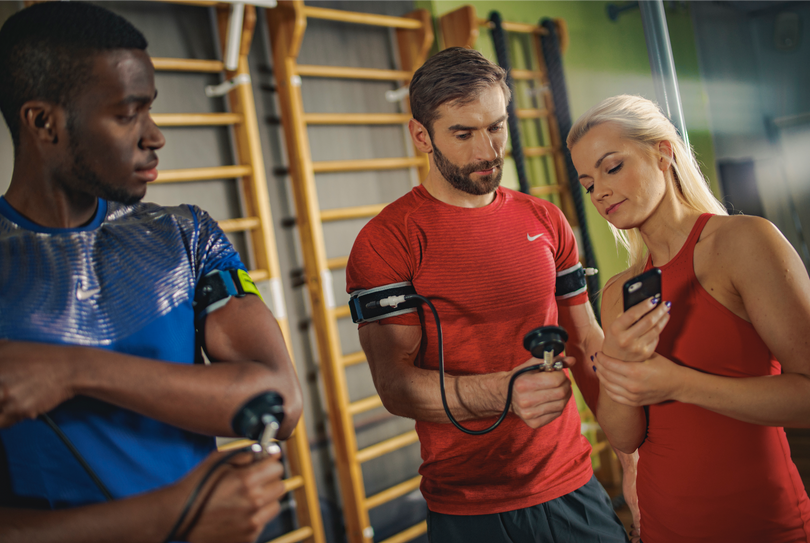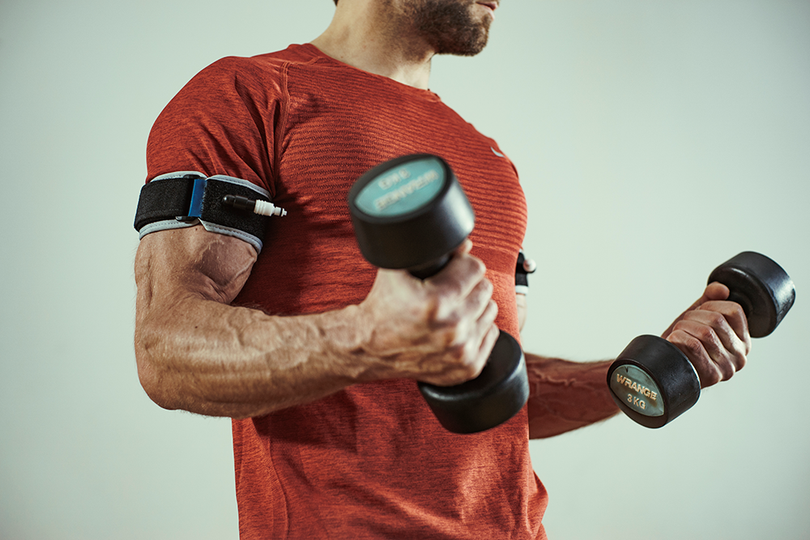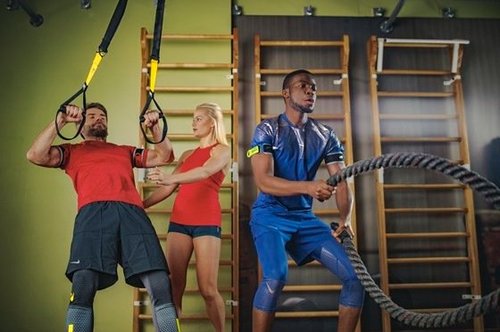Multiple research labs in independent studies have reported that BFR training produces strength gains similar to maximal resistance training (weights). It is important to note that not all BFR techniques and products are created equal. B STRONG proprietary equipment keeps you safe, while make the experience simple, effective, and fast to use.
DOES BFR REALLY WORK?
EFFICACY
DOES BLOOD FLOW RESTRICTION TRAINING REALLY WORK?
HOW LONG WILL IT TAKE TO SEE AN EFFECT WHEN USING BFR BANDS?
By using B Strong BFR bands along with the guidance app, you should see a marked improvement on the order of 10% strength gains in as little as 10-15 sessions if done 3-5x per week, 1x per day. Our application is designed to keep you safe and work your way toward the pressures that are appropriate for you, as each individual is different. B Strong is much more than just BFR bands. We bring you the expertise in an easy-to-implement fashion so you can simply Pump up ‘n Go™.
WHAT IS THE DIFFERENCE BETWEEN B Strong BFR TrainingTM AND NORMAL RESISTANCE TRAINING?
B STRONG BFR Training provides a more robust anabolic stimulation with lighter weights, in a shorter period of time, and in a safer manner, than normal resistance training. Gains in fitness and strength are realized quicker with B STRONG BFR Training than with normal resistance training.
WILL B StrongTM RESULT IN BIGGER MUSCLES AND WEIGHT GAIN?
Leading BFR expert Jim Stray-Gundersen, MD emphasizes that whether an individual gains mass or not depends on their nutrition and other training that they are doing. Blood flow restriction training is really just a signal for an anabolic response. Specific muscles may get bigger, but people also burn fat and many report looking leaner as part of their B Strong BFR training results.
WHAT IS THE EFFECT ON TENDON STRENGTH?
Specifically, the answer to this direct question is not known yet. However, it depends on what the stimulus for tendon adaptation is and that is not known for sure, either. If the trigger is large absolute force loads across the tendon, then BFR will be minimally effective. On the other hand, if the trigger is “number of loads” that could be light, then BFR will work to improve tendon strength. There are a couple of studies on this topic with mixed results.However, with literally millions of BFR sessions performed all over the world with significant gains in muscle size and strength, we do not have any tendon injuries reported. In contrast, abuse of anabolic steroids, can build big strong muscle, but also weaken tendons, sometimes resulting in catastrophic tendon failure and rupture. Further, we do know this builds muscle and bone and tendons are the structure in-between, so it is logical to expect tendons are strengthened, as well as, the muscle and bone.
IS THERE A EUPHORIC EFFECT?
Yes, as with any intense or exhaustive exercise, part of the systemic response from the brain is a release of Beta Endorphin from the pituitary. This natural opiate produces a euphoric effect as well as augments the healing/anabolic response.
THEORY & MECHANISM
SCIENCE
HOW DOES THE B STRONG TRAINING SYSTEMTM WORK?
BFR is a breakthrough in understanding of how the body adapts to training stress and builds muscle, bone, blood vessels and tendons. The B Strong Training SystemTM works by slowing down or impeding the flow of blood exiting the limbs through the veins. As your muscles work, they use up available oxygen and other nutrients and normally the circulation brings more oxygen and removes metabolic waste products. Because the circulation has been impeded, there is not enough re-supply of oxygen to the muscle, nor enough clearing of metabolic waste products. The “environment” of the muscle fiber deteriorates to the point where muscle contraction cannot continue and other muscle fibers have to take over to perform the exercise. Soon all fibers in the muscle go into a state of “failure” and one cannot continue. You recognize this state as muscle burn or fatigue followed by not being able to do anymore repetitions. Your brain senses the distress and responds, as it normally does, by initiating autonomic and hormonal responses in an attempt to mitigate the conditions in the muscle and to adapt to the demands of the exercises. This process is the normal process of adaptation to severe exercise, but usually to get to this state, one must perform severe exercise like maximal weight lifting or many running intervals. This type of severe exercise usually damages the tissues involved. In the case of BFR Training, the situation was created by a combination of light otherwise easy exercises but with the blood flow to those muscles impeded. As a result of the distress in the muscle, growth hormone and other anabolic hormones are released into your blood stream. This hormonal cascade goes throughout the body and facilitates the repair and building of all tissues that have been working or were injured.
Our team is dedicated to pushing the research into understanding all the underlying mechanisms, and establishing optimal application of the B Strong Training SystemTM. Get started today!
WHAT PRESSURES ARE REQUIRED FOR THE BEST SYSTEMIC RESPONSE?
The pressure to produce the best systemic response is one that creates a robust metabolic crisis in the working muscles for a substantial (minutes) period of time. So for example, if the pressure and/or load are so high that only a few repetitions of an exercise are possible, there is not enough time for that metabolic crisis to develop in the muscle and the signal is not sent. On the other hand, if the pressure and/or load are so low that the metabolic crisis takes a long time or never happens, the alarm signal to the brain is not sent, (or sent as if there were no BFR), minimizing a systemic response.
HOW DOES BFR AFFECT TENDONS AND JOINTS IN TERMS OF STRENGTHENING?
The effects of BFR on tendons has not been studied in humans with either normal tendons or injured tendons or tendinopathies. There is a study in horses that showed muscle hypertrophy and no change in tendon thickness. The problem is that an improvement in tendon tensile strength is not related to tendon size or thickness, so it has proved difficult to study the issue.
However, literally millions of BFR sessions are performed annually around the world and there are no reports of tendon ruptures.
Further, there is evidence that muscle is improved and there is evidence that bone density is improved by BFR, so it is likely that the structure in between those two tissues is likewise improved.
Finally, patients/clients with tendinopathies benefit from B Strong BFR sessions by improving their overall fitness and reducing pain in their tendons.
DOES LACTIC ACID HAVE A ROLE IN THE B Strong BFR Training SystemTM?
Yes, lactic acid is one of many factors that helps stimulate adaptation and growth of muscle. However, it is not a goal, in and of itself, to get high lactate levels in blood with the B Strong Training SystemTM. Lactate levels accumulate in muscle fibers when the rate of glycolysis (breakdown of carbohydrates, glycogen and glucose) exceeds the rate of the mitochondria to take in and process carbohydrates with oxygen. By limiting the circulation with the B Strong Training SystemTM, we reduce the ability of the circulation to re-supply oxygen to the working tissue. This results in the earlier onset of high lactate concentrations in a muscle fiber from a workout at much lower absolute work loads.
IF THERE ARE NO MICRO TEARS IN THE MUSCLES WITH THE B StrongTM , WHAT DOES THE INCREASE IN LACTIC ACID AND SUBSEQUENT SECRETION OF GROWTH HORMONES DO?
Micro tears or muscle fiber damage are not necessary to stimulate lactate production or Growth Hormone secretion. It is the disturbance of homeostasis that raises lactate concentrations and stimulates secretion of Growth Hormone and they, in turn, stimulate an anabolic response in exercising tissues.
If it is true that minimal muscle damage is done while doing a B STRONG session without heavy weights, how do people get bigger and/or stronger with the B STRONGTM?
This is one facet of the beauty of the B Strong Training SystemTM. By restricting blood flow in and out of an extremity, it disturbs the homeostasis normally found in muscle and produces the stimuli for adaption with minimal damage to the working muscle. That “disturbance of homeostasis” (generally, increased metabolic acid and decreased oxygen in the muscle and associated metabolic by-products) stimulates development/adaptation locally, as well as, stimulate nerve fibers (Group III and IV afferent fibers, linked to metabo-receptors) to send a signal to the brain to release a systemic anabolic response. Generally, light weights and concentric exercises do not damage muscle fibers, while heavy weights and eccentric exercise can and does damage muscle. The more damage done to a muscle, the longer it takes to repair that damage before moving on to build bigger and stronger muscles.
HOW DOES BFR COMPARE TO OXYGEN DEPRIVATION STRATEGIES AND TRAINING IN HYPOXIA?
Some have asked if oxygen deprivation masks work the same way that BFR belts do in producing hypoxia and then, if so, is that what is producing performance improvements from both technologies. The quick answer is that “No, they work in completely different ways” and while proof is lacking that oxygen deprivation masks improve performance, there is robust data showing BFR training does improve strength and fitness.
Oxygen deprivation masks or rebreathing systems attempt to reduce the oxygen getting into the body through the lungs. This is seen as some as a way to “train at altitude or in hypoxia” while at sea level. First, hypoxic training has NOT been shown to improve sea level strength or endurance performance. Second, by restricting breathing, one may get some gains in respiratory muscle strength, but there is little to no influence on SpO2 so that working muscle has near normal oxygen levels available for work. It is not hypoxic, unlike exercising at altitude or BFR training.
Now regarding hypoxic training (either by exercising at altitudes above 6000 ft or by breathing hypoxic gas mixtures), the SpO2 may be reduced from 95-100% to 85% to 90%. The whole body (importantly including brain, heart and muscle) is exposed to this reduced oxygen in the arteries (hypoxemia). The net effect of a reduced SpO2 is that less work is performed and heart and brain are stressed to a greater extent. However, the actual amount of oxygen delivered to working muscle is not very different from normal sea level training. So due to near normal delivery of oxygen and reduced work performed, the SmO2 (saturation of hemoglobin in muscle) is not very different from normal (perhaps, dropping from 40% to 30%) and there is little disturbance of homeostasis in working muscle. In summary, whole body hypoxic training does reduce oxygen in the blood (SpO2), but oxygen delivery to and concentrations in working muscle (SmO2) is only slightly reduced.
When performing BFR training properly, there is a profound reduction in oxygen in the muscle. Normally, at rest, SpO2 is ~98%, while hemoglobin in muscle is ~70% saturated with oxygen (SmO2 = 70%). When exercising maximally, at sea level, SmO2 may drop to ~40%. With BFR training, SpO2 remains high (95-100%), while oxygen in muscle may drop to less than 10% (SmO2 ~ 10%) as blood flow to the working muscle is restricted. Exercising muscle uses oxygen that must be replaced for the muscle to keep working and to maintain homeostasis. When that resupply of oxygen is restricted, the muscle becomes very hypoxic (SmO2 < 10%) and a metabolic crisis ensues stimulating local processes to reverse the situation. This disturbance of homeostasis is sensed by the brain and in response, releases hormones to facilitate improvement of oxygen transport in the body.
So, in summary, oxygen deprivation masks, hypoxic training and BFR training are all very different techniques, working through different mechanisms, with very different results.
- Oxygen deprivation masks make breathing harder, perhaps, improving respiratory strength.
- Hypoxic training somewhat reduces oxygen in the arterial blood, but minimally impacts the oxygen delivered and used in working muscle. The brain is the organ most sensitive to a reduction in oxygen delivery and adjusts behavior accordingly.
- Proper BFR training does not reduce the oxygen in arterial blood, but severely limits oxygen resupplying working muscle, producing profound hypoxia and acidosis in working muscle, while maintaining oxygen delivery to heart and brain. The profound hypoxia and acidosis, stimulate robust anabolic processes to improve strength, performance and fitness.
IS IT SAFE FOR ME?
SAFETY
WHAT ARE THE SIDE EFFECTS OF USING THE B STRONG TRAINING SYSTEMTM?
We are unaware of any contraindications, negative side effects or complications from using the B STRONG Training SystemTM when performed following the 5 Safety Rules.
- Always place bands in correct locations.
- Never occlude arterial inflow.
- Never lift heavy weights.
- Never exceed 20 minutes of inflation.
- Always use the B STRONG guidance app.
Of course, if there is an ongoing medical emergency (e.g. heart attack, hypertensive crisis, hypoglycemic reaction, stroke, acute injury, etc.), the individual should postpone the B STRONG Training session and seek medical attention.
WHAT ARE THE EFFECTS OF B STRONG TRAININGTM ON THE HEART?
Acutely, during a B Strong training session, heart rate and blood pressure are somewhat higher than they would otherwise be for the given exercise.
Chronically, BFR training has many positive effects on the cardiovascular system, including the heart, similar to the positive effects gained from regular exercise training.
CAN DOING B STRONG TRAININGTM LEAD TO PULMONARY EMBOLISMS OR BLOOD CLOTS?
Not if the 5 safety rules are followed. If blood in deep veins is brought to a standstill for a prolonged period of time, the blood can begin to form clots. If this happens and the clots move into the lungs, they will cause what is called a pulmonary embolis. If big enough, pulmonary emboli can be fatal. Fortunately, the B Strong Training SystemTM Bands are designed so that when the safety rules are followed, they cannot make the blood stand still long enough to clot, and thus, B STRONG Training does not increase the risk of blood clots or pulmonary emboli. Millions of BFR sessions have been performed world wide over the last 50 years and where it has been studied, the individuals who practice BFR have less blood clots detected than a matched group of individuals who don’t do BFR training.
Some individuals are genetically predisposed to clotting. By the time these individuals are adults, they know whether they or others in their families have this condition. Often they are on anticoagulants. B Strong Training is safe even for these individuals.
Sometimes, after particular types of surgery (e.g. various orthopedic procedures on the lower extremities), one may have formed clots in the veins while anesthetized. These clots may go unrecognized and cause a pulmonary embolus in the days following the surgery. Thus, we recommend waiting a week after surgery to resume or start a B STRONG training program.
Some individuals are genetically predisposed to clotting. By the time these individuals are adults, they know whether they or others in their families have this condition. Often they are on anticoagulants. B Strong Training is safe even for these individuals.
Sometimes, after particular types of surgery (e.g. various orthopedic procedures on the lower extremities), one may have formed clots in the veins while anesthetized. These clots may go unrecognized and cause a pulmonary embolus in the days following the surgery. Thus, we recommend waiting a week after surgery to resume or start a B Strong training program.
WHAT IS THE RELATIONSHIP BETWEEN MY BLOOD PRESSURE AND THE B STRONG TRAINING SYSTEMTM PRESSURE?
When one uses a blood pressure cuff, or surgical tourniquet, and if it is applied at a pressure higher than systolic blood pressure, occlusion can occur. So with those systems, there is an important relationship between cuff pressure and blood pressure.
The B Strong BFR BandsTM, by virtue of the width, construction, and material properties, has been designed so it cannot occlude the circulation. Therefore, from a safety standpoint, the pressures prescribed in the B Strong Training SystemTM pressure has little or no consideration to a person’s blood pressure.
The pressure in the B Strong BFR BandsTM restricts or impedes venous blood from returning to the central circulation. The higher the pressure, the more blood is held in the limb and the more the circulation is slowed. The higher the pressure, the greater the muscle force needed to push blood past the impediment and back to the central circulation. In contrast to BP cuffs and tourniquets, the pressure prescribed for B Strong BFR Training SystemTM has little or nothing to do with the individual’s blood pressure.
WHO SHOULD NOT DO THIS?
As with any exercise program, all practioners of B Strong BFR TrainingTM should use common sense in deciding if they should proceed with a session. They should consult their physician if they have any questions about their particular circumstances. There are very few situations where people should not use the B Strong BFR SystemTM.
- People should wait one week after major surgical proceedures before starting or resuming B Strong BFR TrainingTM. This caution is primarily given to give time for asymptomatic, untreated deep venous thromboses to be identified and treated.
- People should not put (B)STRONG Belts directly on healing incisions or wounds. If, for example, there is an incision on the outside of the thigh (as in a total hip replacement) where the leg belt would go, the individual should avoid placing a leg belt directly on the incision, but they can enjoy BFR training on the other three extremities.
- Women, if they know they are pregnant, should wait until after delivery before starting (B)STRONG BFR Training. Note: as with any exercise, if they have been BFR training prior to discovering they are pregnant, no need to stop. They may do BFR training, on the easy side, until they feel uncomfortable doing (B)STRONG BFR Training (usually in the last trimester). they should consult their obstetrician if they have any questions or are a high risk pregnancy.
- If a person’s limb girth in the appropriate belt location is less than 19 cm (7.5”), that limb (usually an arm) is too small for our smallest belts. We have only seen this situation with children weighing less than 60 lbs. They may enjoy (B)STRONG BFR Training on their legs only.
- If a person’s limb girth in the appropriate belt location is greater than 95 cm (37.5”), that limb (usually a leg) is too large for our largest belt. We have not run into this situation yet, but those individuals may enjoy (B)STRONG BFR Training on their arms only.
- If someone is having a medical emergency of any sort, he/she should stop BFR training, call 911 and/or go to the emergency room and seek care.
- People should not operate a vehicle while doing BFR training. However, it is fine for passengers to do so, as long as they do not distract the driver.
- If a person has a condition that has produced lymphedema, he/she should avoid BFR on that extremity and they should consult their physician before proceeding.
- If a person has iatrogenic vascular access on an extremity (e.g. hemodialysis patients), he/she should avoid BFR on that extremity and they should consult their physician.
- If a person has untreated deep venous thromboses, he/she should not do BFR training until they are treated.
- If a person is in hypertensive crisis or has untreated hypertension, he/she should seek medical attention and then when their hypertension is controlled, proceed with BFR training, after they have consulted their physician.
WHAT ARE THE RISKS?
As long as the safety rules and cautions are followed, and B StrongTM equipment and guidance app are used and followed, there are no risks associated with B Strong BFR TrainingTM beyond those associated with any exercise. Please consult your with your physician before starting any exercise routine, including B Strong BFR TrainingTM.
CAN B STRONG BFR TRAINING SYSTEMTM PRESSURE GO OVER YOUR SYSTOLIC (OR DIASTOLIC) NUMBER?
Yes, it is almost always higher than one’s systolic blood pressure. The pressure in the B Strong BFR BandsTM is only loosely related to blood pressure. The pressure in the B STRONG BFR band is adjusted so that muscle contraction overcomes the venous impediment to maintain blood flow even up to 500mmHg. See our safety video demonstrating this.
COULD B STRONG BFR BANDSTM PUT YOU AT HIGHER RISK OF VARICOSE VEINS?
No, B Strong BFR Training SystemTM Bands and protocols do not increase the risk of varicosities, if anything, B Strong works toward reducing varicosities.Varicose veins are the result of incompetent valves in the veins linking the deep to superficial venous systems. They can occur for a variety of reasons, but one cause is pregnancy where the growing uterus and baby put 24/7 pressure on the iliac veins as they carry blood back to the heart. This fills up the deep veins, the interconnecting veins and the superficial veins. Because this is a passive, constant situation, the valves are stretched resulting in them becoming incompetent.
In contrast, during B STRONG training, venous outflow is restricted leading to distension in the veins and capillaries distal to the B STRONG Band, but then with exercise, the veins are repeatedly emptied and filled. This has been associated with a up-regulation of markers associated with vascular growth (VEGF, HIF-1a, etc.). The result of this temporary (~20 minutes) distending and emptying of the veins and capillaries is to improve their smooth muscle, which if anything works to reinforce the valves in between the deep and superficial venous systems. B Strong may actually result in making barely incompetent valves, competent again, which, in turn, may reduce the amount of varicosities. We have numerous anecdotal reports of reduced varicosities when regularly using the B Strong Training SystemTM.
CAN THE B STRONG TRAINING SYSTEMTM BE USED EVEN AFTER AN INJURY LIKE A BONE BREAK OR MUSCLE TEAR?
Yes, B Strong is uniquely suited to allow continued strength training while not disturbing the healing injury. If, for example, one tears their right ACL, they may continue B Strong BFR TrainingTM on the other three extremities as normal. In addition, they may perform light B Strong BFR TrainingTM on the injured extremity as long as it does not produce pain in the injured part.
WHEN SHOULD YOU NOT DO B STRONG BFR TRAININGTM?
One should wait 3 days after a general anesthetic before resuming B Strong Training sessions. Out of an abundance of caution, we do not recommend pregnant women to start B Strong TrainingTM sessions during their pregnancy. One should definitely not do B Strong TrainingTM when dehydrated. In this case, please rehydrate, then proceed with the B Strong TrainingTM session.
WHAT IS THE RISK OF RHABDOMYOLYSIS FROM THE B STRONG TRAINING SYSTEMTM?
There is a very low risk of Rhabdomyolysis. Rhabdomyolysis does not occur when individuals follow the safety rules of the B Strong BFR Training SystemTM. A constellation of factors must occur together to get rhabdomyolysis. Rhabdomyolysis is associated with a variety of factors including; the first time of a new exercise, exercising when dehydrated, eccentric exercise, exercise with an occluded circulation, exercise with heavy weights, exercise of long duration. There is a comprehensive list below. It takes a “perfect storm” of many of these factors coming together to get wide spread muscle fiber damage that can lead to rhabdomyolysis. If one follows the B Strong BFR Training SystemTM safety rules, one can not get all these factors coming together at the same time.
Rhabdomyolysis is defined as major destruction of muscle fibers. As muscle fibers are torn and damaged, the intracellular contents are released into the circulation and the kidney attempts to clear them from the circulation. If the load of cellular debris is too great for the kidneys, renal failure ensues. If not treated, death follows. There are many causes of rhabdomyolysis. The most common causes include:
- The use of alcohol or illegal drugs such as heroin, cocaine or amphetamines
- Extreme muscle strain (especially in someone who is an untrained athlete; it can happen in elite athletes and can be more dangerous if there is more muscle mass to break down)
- A crush injury such as from an auto accident, fall, or building collapse
- Long-lasting muscle compression such as caused by prolonged immobilization after a fall or lying unconscious on a hard surface during illness or while under the influence of alcohol or medication
- The use of medications such as antipsychotics or statins, especially when given in high doses
- Electrical shock injury, lightning strike, or third-degree burn
- A very high body temperature (hyperthermia) or heat stroke
- Seizures
- A metabolic disorder such as ketoacidosis
- Diseases of the muscles (myopathy) such as congenital muscle enzyme deficiency or Duchenne’s muscular dystrophy
- Viral infections such as the flu, HIV, or herpes simplex virus
- Bacterial infections leading to toxins in tissues or the bloodstream (sepsis)
NOT ALL SYSTEMS ARE CREATED EQUAL
DIFFERENT METHODS
WHAT IS OCCLUSION TRAINING AND WHY IS IT DANGEROUS?
Occlusion training involves completely stopping blood flow into an extremity for substantial periods of time. It can damage tissue distal (below) to the occlusion. Completely occluding a limb for a substantial period of time increases the risk of blood clots in veins. Deep venous thromboses (DVT’s) can lead to pulmonary emboli, which can be fatal. Occlusion training can also lead to rhabdomyolysis (severe breakdown of muscle fibers), which can lead to kidney failure and possibly death.
WHAT IS THE DIFFERENCE BETWEEN OCCLUSION TRAINING, AND BLOOD FLOW RESTRICTION TRAINING?
See the safety video where we compare occlusion training with a blood pressure cuff and the B Strong Training SystemTM. The difference between occlusion training and BFR Training is that in the former case, the limb’s blood flow is occluded and in the later, some blood flow is always maintained.
IS B STRONG BFR TRAININGTM A FORM OF OCCLUSION TRAINING?
No, B STRONG BFR Training does not, if safety rules are followed, totally occlude blood flow in a limb (safety rule #2), while that is what occlusion training seeks.
IF INDIVIDUALS CAN EASILY WRAP THEIR OWN ARMS WITH BANDS OR SURGICAL TUBING, WHY PURCHASE A B STRONG TRAINING SYSTEMTM?
Because the B Strong BFR SystemTM is designed to be both safe and effective. Surgical tubing or elastic wraps vary tremendously in how they influence the circulation. With surgical tubing or elastic wraps, one has little knowledge of whether they are safe or effective. In addition, B STRONG Bands are likely to be much more comfortable than surgical tubing or blood pressure cuffs.
The B Strong Training SystemTM emphasizes safety and pays great attention to getting the pressures right. When too much pressure is used, dangerous blood vessel occlusion can result. The application of too little pressure is not effective in producing the benefits of the B Strong Training SystemTM. The patented B STRONG Bands are specifically designed to provide a safe, comfortable and effective B STRONG experience.
WHAT % OF ARTERIAL FLOW RESTRICTION ARE B STRONG BFR BANDSTM ABLE TO OBTAIN?
The only important safety point is that B Strong BFR BandsTM can not occlude arterial inflow in an extremity up to the limit of the hand pump (500 mmHg) when instructions and guidelines are followed. All complications, or negative side effects with BFR occur as a result of occluding the arterial inflow into a limb. Since B Strong BFR BandsTM are incapable of occluding (up to the limit of the pump) when used correctly, they are eminently safe.
The effectiveness of B Strong BFR TrainingTM is not about what percentage of arterial flow is restricted, but rather the robustness of the metabolic crisis signal occurring in the working muscle and being sent to the brain. The “robustness” of the metabolic crisis signal is a function of the amount of venous outflow restriction that prevents recovery in the working muscle, the duration of that metabolic crisis signal and the percentage of the body’s muscle mass sending that signal.
PUTTING IT TO PRACTICE
APPLICATIONS & TECHNIQUE
WHO USES THE B STRONG BFR SYSTEMTM?
The B Strong Training SystemTM can be safely and effectively used by injured and non-injured athletes, as well as normal people of every age, ability and background. In our experience, we have used the B Strong Training SystemTM on both genders from 10 to 93 years of age.
WHAT IS THE BEST WAY TO START B STRONG BLOOD FLOW RESTRICTION TRAINING?
The best way to start using the B Strong Training System™ is to measure your limb girths, order a system, fill out the information and download the app. The app will take you from there, track your progress and prescribe appropriate pressures to keep your sessions safe and effective!
WHAT TYPES OF EXERCISES CAN YOU DO WITH B STRONG TRAINING SYSTEMTM?
You can do any exercise you can imagine with your B Strong Training System™. The most important point is to follow the guidance of the app. In the app, you should follow the B Strong regimen for sets and repetitions to achieve muscle failure.
Any light weight or partial body weight exercises can be performed with the B Strong Training System™. Jim Stray-Gundersen, MD, BFR expert and co-founder of B Strong, recommends starting with the basic exercises described in the app, then gradually incorporating exercises most specific to the activities relevant to your lifestyle. Examples include cyclists “B-ing” Strong on a stationary bike with BFR bands on their legs or baseball players throwing with BFR bands on their arms.
WHAT IS THE APPROPRIATE LEVEL OF PRESSURE WHEN USING THE B STRONG TRAINING SYSTEMTM?
The proper B StrongTraining SystemTM pressure varies between individuals depending on a variety of biometric factors. The B Strogn guidance app has an algorithm that takes these factors into account. That is why the regular use of the app is very important. The appropriate level of pressure is set by the app and updated based on feedback given after each session.
CAN I USE ISOMETRIC EXERCISES IN MY B STRONG BFR TRAINING SESSION? DO YOU HAVE AN ISOMETRIC EXERCISE PROTOCOL?
Yes, essentially substitute a 3 second isometric contraction for each repetition of an exercise movement. Once you have the belts inflated, and instead of doing the usual exercises, perform 3 sets of 30 isometric contractions of the interested muscle. When contracting, hold the contraction for 3 seconds and then relax for 1 second and repeat 29 times before resting for 30-60 seconds. Perform 3 sets of these 30, 3 second isometric contractions for a given muscle group before moving to the next exercise. These isometric contractions are particularly useful if you have a joint injury that is aggravated and painful if moved during exercise. You can combine isometric exercises with movement exercises in other areas of the body. One thing many find that are interested in big hypertrophic muscle gains is that isometric contractions and very slow moving contractions are particularly effective in building muscle. One can also combine isometric and normal contractions in a given exercise. For example, when doing 5 lbs arm curls, one can hold an isometric contraction at the end of the range of motion, both with the arm fully flexed and the arm fully extended.
CAN I USE B STRONG IF I HAVE SUFFERED A STROKE? HOW WOULD I USE IT?
Regular exercise is an important component of rehabilitation for patients with stokes (CVA’s). B Strong BFR is ideally suited to produce significant gains in function in patients who have had a stroke. This can have a dramatic effect on the individual’s activities of daily living. The result can have the patient be independent, as opposed to dependent on additional daily care. In particular, if the patient is hypertensive (has high blood pressure), their blood pressure should be medically controlled.
We have used B Strong BFR with several stroke patients and there have been many patients in Japan (using the predecessor of B Strong, Kaatsu) that have been helped by BFR training. To some extent, it depends on how “dense” (complete) the stroke is. The “denser” or more severe the stroke, the less chance of functional recovery.
- Typically, what nerves (and motor pathways) have been killed, are dead, but there is a lot of recovery that can take place to get the individual functional again.
- B Strong can strengthen the motor pathways/muscles that are still innervated.
- B Strong can restore damaged, not dead, motor pathways to function.
- B Strong can facilitate healthy neurons to take over the function of dead neurons.
WHAT PERCENTAGE OF 1RM SHOULD BE USED WITH THE B STRONG BFR TRAININGTM?
Several studies have used from 10-20% of 1RM. However, one repetition maxes (1RM) are specific for each lift, difficult (and sometimes dangerous) to measure accurately and change almost daily. One of the principles of the B Strong TrainingTM is that light weight loads or resistances should be used. To clarify, light loads or light resistances are those that are easy to do or where many repetitions can be done without the B Strong BFR Training SystemTM. A good example of a light exercise is arm curls with 2-5 lbs (1-2 kg) barbells. Any calisthenics where partial body weight is moved are also good examples of B Strong exercises, like push-ups.
IS IT USEFUL TO SIMULTANEOUSLY USE THE B STRONG BFR TRAINING SYSTEMTM ON BOTH YOUR ARMS AND LEGS?
We recommend that you start your BFR experience with just arms or just legs at once. Get used to the feelings and the exercises and ease your way into the training. As you become more experienced after a couple sessions, you may apply all four belts at once and incorporate more complex movements or calesthenic exercises. It is important to be well hydrated during all B Strong sessions, and especially when you have four belts at once because you are pooling a larger blood volume in your limbs. If you ever feel light headed during any workout, stop, remove the belts, hydrate and eat something and try again later or the next day.
WHAT IF I DO NOT WANT TO PUT ON EXTRA MUSCLE?
You don’t have to put on extra muscle with B Strong. It depends on your athletic and fitness goals. The changes to body composition that occur with B Strong are also dependent on your diet and other types of training you perform. For example, a body builder can put on extra weight and muscle with B Strong, while an endurance athlete will get stronger and leaner without appreciable gain in body weight.
HOW MANY TIMES PER WEEK SHOULD I DO B STRONG BLOOD FLOW RESTRICTION TRAINING SESSIONS?
B Strong blood flow restriction training sessions have been performed as much as 2 to 3 times per day to as little as twice per week. Competitive athletes in their 20s may do a B Strong session daily. While you recover quicker from a B Strong session than a maximal heavy lifting session, it still can be taxing. Olympic Physician and BFR expert Jim Stray-Gundersen, MD recommends gaining some experience in how the B Strong session makes you feel, then adjusting your overall training stress to accommodate your individual appetite for blood flow restriction training.
CAN YOU USE B STRONG BFR ARM & LEG BANDS AT THE SAME TIME?
Yes, you can use B Strong blood flow restriction bands on both your arms and legs at the same time. It is 2x as efficient as many other BFR systems! B Strong allows safe full body exercise with our arm and leg package.
IF I WANT TO DO B STRONG ONLY ON MY LEGS, WHAT IS RECOMMENDED?
Doing B Strong on legs only is just fine. However, you will get a more robust systemic anabolic effect, if you also include a B Strong arm session. The greater the percentage of your total body musculature that you get sending a signal of disturbed homeostasis to your brain, the more robust of an anabolic systemic response you will get.
HOW DO I WORK MY CORE WITH THE B STRONG SYSTEMTM?
If you incorporate the use of core muscles into your B Strong exercises, they will enjoy the similar adaptive responses as muscles that are distal to the B Strong belts. For example, if you do push-ups with B Strong arm belts, not only do you stimulate development of your triceps, but also your pectoralis and core musculature, as you hold a good “plank” during the push-ups.
IS THERE A RECOMMENDED PERIOD OF TIME TO USE B STRONGTM?
There is no optimal time to use B Strong. However, you may enjoy your B Strong blood flow restriction training session more if you establish a regular schedule. It is not recommended to do B Strong right after a large meal and for some, doing B Strong or any exercise just before bedtime may impact their ability to fall asleep.
ARE MORE SESSIONS BETTER? I.E. HOW OFTEN SHOULD SOMEONE PERFORM A B STRONG TRAINING SESSION. WILL MULTIPLE TIMES PER DAY INCREASE PERFORMANCE? WOULD BACK TO BACK SESSIONS (MEANING ONE WORKOUT, RELEASE OF BANDS, AND THEN ANOTHER WORKOUT) IMPROVE PERFORMANCE?
The answer does depend on individual circumstances like, fitness, training background, age, purpose of training, etc. in terms of how often to exercise. However, the number of sessions can range from twice per week to as many as 3 sessions per day.
Why the form of three sets of 30 reps of 3 to 6 exercises, is an important part of the mechanism of blood flow restriction. With blood flow restriction training, we are limiting the ability of the muscle to recover from otherwise easy exercise by restricting or impeding its blood flow. During easy/light exercise we only use a fraction of the fibers in the muscle to perform the movement. However, the first fibers that are recruited are heavily dependent on blood flow (oxygen, glucose, removal of acid, etc.) to operate. Because they don’t get their normal blood flow during the 1stset, they begin to fatigue. Then during the 30 second “rest” period, when normally muscle recovers, now without muscle contraction, they have even less than the normal blood flow moving through the muscle and get in even moremetabolic trouble, rather than recovering and improving the situation. Then when the 2ndset starts, it is starting on fibers that have not recovered, which results in those fibers failing to generate necessary force. Additional fibers (not normally recruited for easy exercise) have to take over. These fibers are usually less trained and get in metabolic trouble even faster, resulting in even more metabolic trouble. Now during the 2ndrest phase, most if not all fibers in a muscle are now in “metabolic trouble” and aren’t recovering. The 3rdset finishes the whole muscle off and makes virtually all fiber populations contract. In this way of limiting recovery of the initial fibers recruited, one ends up recruiting all fibers. The metabolic waste of all these fibers triggers metabo-receptors in and around the muscle, that send the signal to the brain to release a systemic anabolic response. In addition, these metabolic changes are a local stimulus to increase protein synthesis and to up-regulate anabolic receptors on muscle membranes. In total, the “failure” or “fatigue” generated from 3 sets of 30 reps to failure, is the specific signal that stimulates increases in strength and function in muscle. The only other way to get this degree of disturbance of homeostasis is to lift heavy or maximal running intervals with “tying up” at the end.
There is an important concept, here, that is a paradigm shift from standard training. Normally, people think they train a given muscle group to get that group stronger or more trained. We are not training muscle (e.g. the biceps) to make that muscle more trained. That gets done, but the important point here is to use that contracting muscle to send a signal to the brain to elicit the systemic anabolic response.
Why 3 to 6 different exercises? We use 3 to 6 exercises to invoke that “disturbance of homeostasis” signal in as great a percentage of total muscle mass as we can. However, as with any training program, one has to start gradually. So typically we start with 3 exercises that cover all muscles distal to the bands and as the person adapts, we add on more exercises that also recruit muscle proximal to the bands and involve core musculature.
SHOULD BFR BE DONE BEFORE, DURING, OR AFTER A NORMAL WORKOUT?
All of the above and you can add in, “instead of” a normal workout. When introducing BFR to a group of athletes that are already engaged in vigorous training, one strategy is to add the BFR workout at the end of the normal workout. Several reasons. First, they can do their normal workout with their normal feelings to judge how hard or how much they do, not influenced by the BFR workout. Second, we use the “normal” workout to induce some metabolic disturbance, which reduces the time needed to cause all fibers to fail (see above). Third, it is a hard (if not impossible) sell to have a group completely abandon what they have traditionally done. You may establish a beach head by adding BFR training to the end of what they normally do. Then as they see their strength and fitness improve, they usually reduce the amount of “normal” training. With “power” athletes, we never go completely away from traditional training, but with endurance athletes, (partially because of the penalty of weight gain), we move to nothing but BFR training exercises for their strength training. A final consideration is that if the athlete tries to do their normal program plus BFR (3 to 5 times per week), they may, over time, get too tired. So what they do and what they cut out or replace with BFR must take into consideration with their overall training load.
B StrongTM can also serve as a great warmp up prior to a training session. In this case, you do not do a full workout to failure but put the belts on and pressurize during stretching exercises or warmup routines. Blood is pooled and forced deep into the capillaries and veins and helps to get things going and wake up the body in preparation for the workout.
HOW SHOULD A TRAINER INTEGRATE BFR INTO THEIR ROUTINE?
BFR training needs to be considered significant training, so a full on maximal BFR session should not be done when recovery is sought. However, some versions of BFR training are intended to facilitate recovery and can be done with that purpose in mind. Versions are also used as part of the warm-up routine before a heavy training session or competition. All other things being equal, BFR training (since the absolute loads are low) does relatively little muscle damage and recovery from a hard BFR session is quick and prompt. So, for example, where standard heavy weight training usually has 48 hours between maximal sessions, BFR training can be performed daily in most athletes used to hard training.
WHERE DO I PLACE THE B STRONG BFR BANDS?
B Strong BFR bands are only placed in two locations.
For arms, the BFR bands are placed high up, above the bicep and below the deltoid. The bands are designed thin enough to get above the bicep so that when the bicep contracts, the bands allow some expansion of the muscle. If you experience any kind of pain, it is likely because the bands are placed too low.
For legs, the BFR bands are placed as high up on the quad as is comfortable.
For both arms and legs, the white valve should be pointing inward toward the opposite side of your body and if there is a gap between the two ends of the bladder, this should be rotated so it is on the outside surface of the limb.
According to leading BFR expert Jim Stray-Gundersen, MD, the reason BFR bands are only placed in these two locations is that it allows B Strong to restrict flow to the maximum amount of muscle mass. B Strong produces a systemic effect, which means your whole body will benefit from the exercise if you are doing exercises that engage core and trunk muscles. So, if you are looking to improve calf or ankle function, you don't put the bands around the calf, as this leaves out the large quad and hamstring muscles and will produce a minimal systemic effect.
HOW TIGHT SHOULD I PUT THE BFR BANDS ON INITIALLY?
B Strong BFR bands should be snug against the limb before there is any air inside. Make sure bands are fully deflated prior to putting them on. Pull the tail strap through the metal loop and pull snug so that the bands cannot rotate or slide freely on the limb. If your arm is on the smaller end of the size range, the two ends of the bladder will overlap, and this is by design. Watch the video in the app called "Band Placement" for more tips.
When you have the BFR bands properly tensioned prior to inflation, you will already start to feel some small restriction, notice some color change in the limb and have distended veins. You should not tighten as hard as you can, but you do want the bands nice and snug against the skin.
HOW DO I CONNECT THE PUMP AND RELEASE AIR?
To connect the pump, take the white female connector on the pump and press the silver lever down so that the round opening is clear and not blocked by the metal lever.
Push the female connector onto the white male connector on the valve until you hear a "click". It is important you push far enough to hear the click or the pump will not be fully connected even though it may appear to be connected.
To release the pump, push down on the silver lever and pull the female connector off the band. If you need to release air during use, or re-pump the band, always deflated the band by pressing in the tip of the male connector on the band.
TIP: if the female connector is difficult to slide onto the male, it may help to touch some vegetable oil with your fingers and rub over the male connector on the bands to lubricate it.
WHAT IS THE IMPORTANCE OF ACHIEVING FATIGUE DURING BLOOD FLOW RESTRICTION TRAINING?
The goal of every B Strong blood flow restriction training session is to achieve strong "fatigue" or "failure.” We define this as not being able to complete another quality repetition. If your cadence is slowing down, or your form is falling apart, you are reaching fatigue.
Producing strong muscle fatigue during the blood flow restriction training session is the trigger for the anabolic response we are looking for. Jim Stray-Gundersen, MD, BFR expert and co-founder of B Strong, recommends the B Strong app to help you get your starting pressures and adjust them over several sessions to the point where you are reaching this strong level of fatigue. We have some exercise samples provided and videos that discuss this more via our app.
CAN I USE B STRONG AFTER GETTING MY BLOOD DRAWN (PHLEBOTOMY)?
It is advisable not to place a B Strong band above a phlebotomy site for several hours post phlebotomy due to the risk of hematoma at the venapuncture site. Performing a standard B Strong session with the other 3 extremities can be done post phlebotomy.

